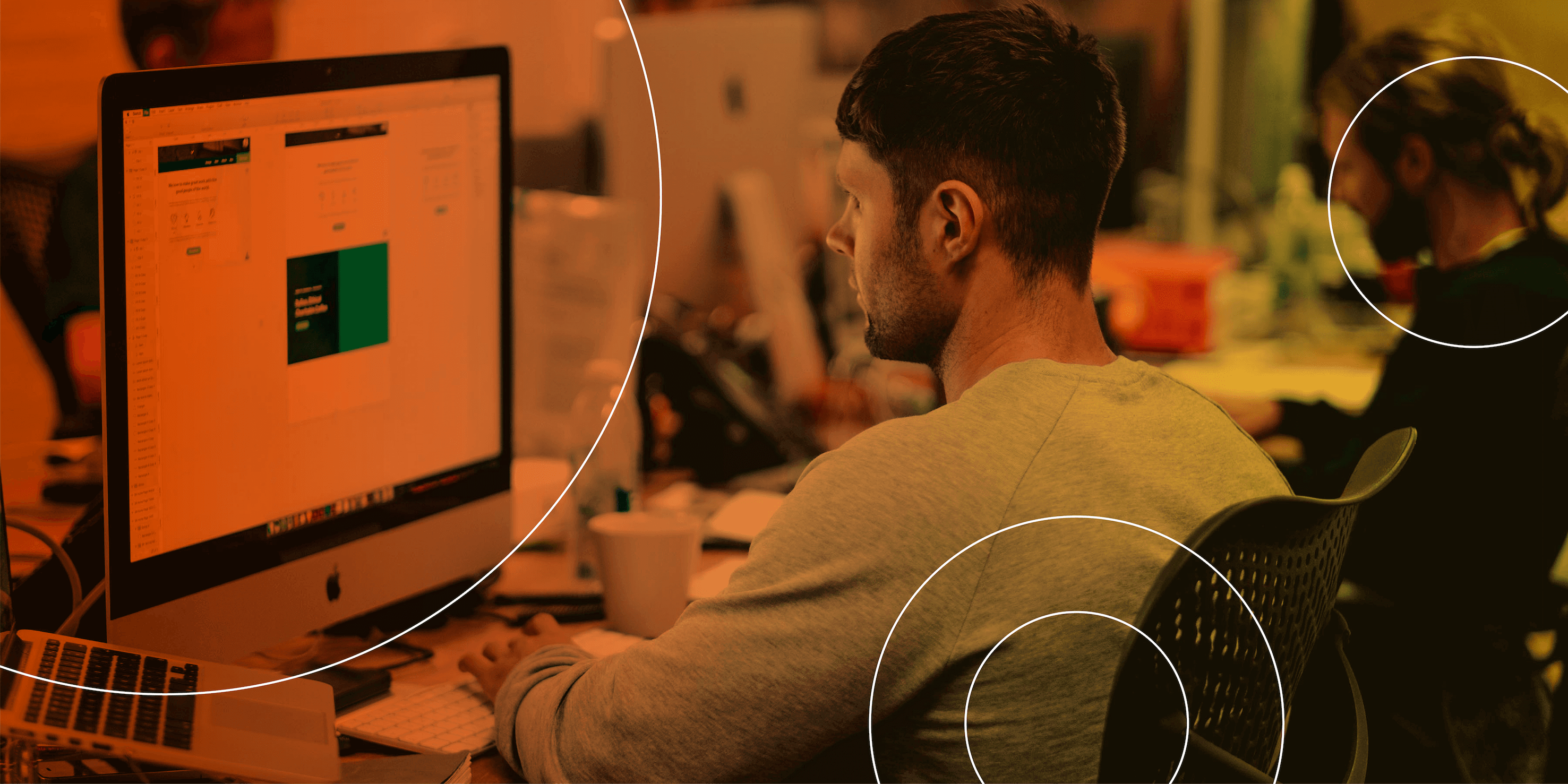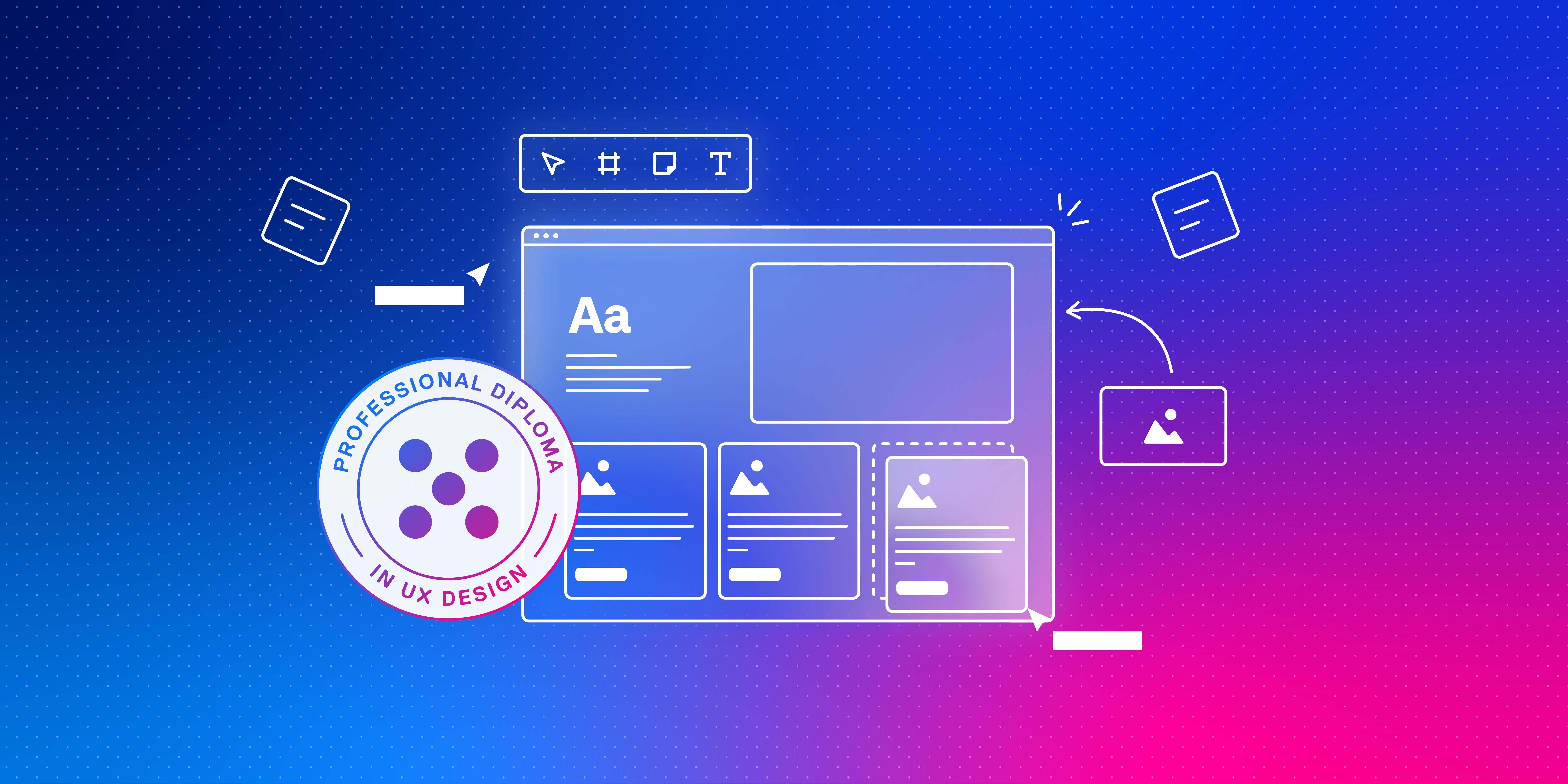Whether you’re a novice UI designer or already have some experience, it’s important to continue honing your craft and improving your skills. The best UI designers are constantly learning, growing and broadening their horizons — and you can do the same.
Here are 9 actionable tips on how to become a better UI designer. Start implementing them and you’ll see your UI skills go from strength to strength.
Click these links if you want to go to a specific tip faster:
- Get to grips with UX
- Design for inclusivity and accessibility
- Explore (and learn from) different design systems
- Practice as much as possible
- Seek out and embrace feedback
- Experiment with different tools
- Take inspiration from UI Design and tech trends
- Stay curious and learn continuously
- Level up with a professional certificate in UI design
1. Get to grips with UX
You can’t have good UX without good UI. And, while it’s true that UX and UI are two different things, the best UI designers understand what UX design is and are familiar with the underlying principles.
If you want to become a better UI designer, brush up on your UX knowledge. Learn about:
- The process that UX designers follow, from user research and defining the problem through to prototyping and testing
- The psychology of UX design, exploring concepts such as Hick’s Law, the Gestalt principles, priming, and the Von-Restorff effect
- User-centred design and how it informs the decisions a UX designer makes
Having a solid handle on UX will help you to be a more empathetic, user-centric designer—and an excellent colleague for your UX design teammates.
2. Design for inclusivity and accessibility
If you want to be a truly outstanding UI designer, make inclusive and accessible design a priority. This is the only way to design for all users, and your work will automatically improve as a result.
So what exactly do we mean by inclusive and accessible design? As per the University of Cambridge’s inclusive design toolkit, the British Standards Institute defines inclusive design as:
“The design of mainstream products and/or services that are accessible to, and usable by, as many people as reasonably possible… without the need for special adaptation or specialised design.”
Accessible design can be defined as:
“A design process in which the needs of people with disabilities are specifically considered.”
Another critical concept is universal design:
“The design and composition of an environment so that it can be accessed, understood and used to the greatest extent possible by all people regardless of their age, size, ability or disability.”
Strive to design with inclusivity and accessibility in mind and you’ll not only be a better UI designer; you’ll also make the world a better place.
3. Explore (and learn from) different design systems
A design system is essentially a collection of UI elements and components that can be reused in different combinations. Designers refer to a design system in order to adhere to style guidelines and standards, ensuring consistency across different designs or products within the same brand. Some of the most well-known design systems include Google’s Material Design system, Microsoft’s Fluent Design system, and Shopify’s Polaris design system.
As a UI designer looking to improve your skills, design systems are a great tool for deepening your understanding of UI design principles and best practices — and seeing how big brands use them to create designs at scale.
In your quest to become a better UI designer, spend some time exploring different design systems. Here is a great guide to the 10 best design systems and how to learn from them.
4. Practice as much as possible
This is arguably the best way to become a better UI designer: getting as much practice as possible.
There are many different ways to practice and apply your UI design skills — such as volunteering your skills for free, using a design challenge generator to come up with project ideas or doing an unsolicited redesign. An unsolicited redesign is where you take an existing product and redesign it. For example, you might choose to redesign the UI of your favourite app.
The more you practice, the more you’ll be able to improve your craft and identify areas that you want to work on. Completing hands-on projects also has the added benefit of helping you to build your UI design portfolio — which you’ll need in order to demonstrate your skills to employers.
5. Seek out and embrace feedback
As a newcomer to the field, there’s a lot you can learn from experienced UI designers. If you want to be a better UI designer, be proactive in seeking out feedback on your work — and be sure to embrace it.
This step might require a bit of networking (which is never a bad thing). Some effective ways to connect with experienced designers include:
- Reaching out to designers at your company (if you’re working)
- Joining online design communities (you’ll find a list of the best ones here and here)
- Connecting with designers on LinkedIn
If you’re connecting with designers out of the blue, lead with a friendly message explaining that you’re new to the field and are hoping to learn from more experienced designers. Once you’ve established a bit of a rapport, you can ask if they would be open to reviewing your work.
When it comes to getting feedback, make sure you’re clear on exactly what aspects of your work you’d like to have reviewed and critiqued. This will help to keep the feedback focused and valuable. And, of course, be sure to take the feedback on board and learn from it.
6. Experiment with different tools
UI designers use a range of tools to create beautiful designs. There are lots of different options out there, so you’ll want to get familiar with those that are considered industry-standard — and then find the one that works best for you.
Having at least basic proficiency in a variety of popular UI tools will give you an advantage when applying for jobs (most job ads will ask for proficiency in a specific tool). Besides that, exploring a range of different tools will allow you to pinpoint the one that you most enjoy using — enabling you to do your best UI work.
But where to start? We’ve compiled a guide to the most popular UI design tools. Check it out and get experimenting!
7. Take inspiration from UI design and tech trends
If you want to be a better UI designer, it’s important to keep your finger on the pulse of the industry. You don’t need to follow every new trend religiously or incorporate it into your own work, but it’s certainly valuable to take inspiration from what’s happening around you.
Fortunately, staying on top of the latest UI and tech trends is as easy as a Google search. Type in “latest UI design trends” and you’ll be inundated with articles and YouTube videos! At the same time, keep an eye on what your favourite brands are doing. If a big brand implements a major design overhaul, you can bet that’s a sign of a new trend on the way.
Stay up-to-date with what’s going on in the industry and you’ll be quick to learn about, and adopt, best practices and trends as they emerge.
8. Stay curious and learn continuously
The digital design field is constantly evolving, and the best UI designers evolve with it. If you want to be a better UI designer, stay curious and get in the habit of continuous learning.
If you can, build thirty minutes or so of dedicated learning time into your week. Watch YouTube tutorials to learn new skills, listen to UI design podcasts, and regularly check your favourite UI design blogs.
Some great UI design resources include:
- The UI Breakfast podcast
- The UI Narrative podcast
- Toools.design—an archive of over 1,000 design resources, updated weekly
- The Material Design blog
- The Tubik blog
9. Level up with a professional certificate in UI design
In keeping with the topic of continuous learning, consider levelling up your UI design skills with a professional course.
If you’re a complete novice, a course will teach you the most important UI design skills, from interactivity and typography to colour, iconography, imagery, and beyond. If you’ve already got some UI knowledge, a formal qualification will improve and affirm your existing skills.
The 12-week online course offered by The UX Design Institute covers everything you need to be a better UI designer, including project and portfolio work and an introduction to essential UI tools. You can learn more about the course here.
Want to keep learning about UI design? See what UI designers typically earn in our UI salary guide.




